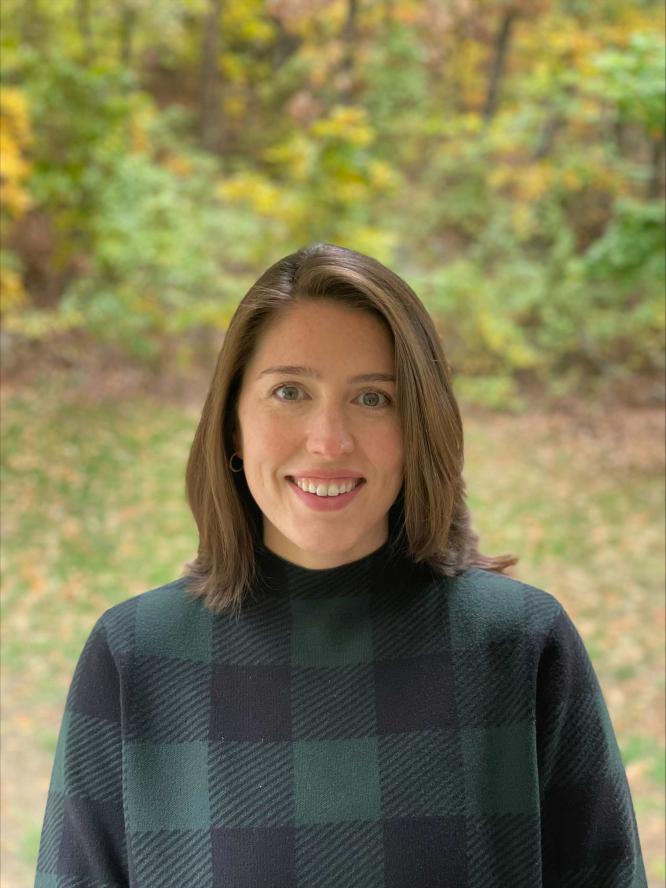Finding Relief in Virtual Reality

Lila Toomey, MA ‘17, helps affix a headset over a client’s eyes and a tropical scene unfolds before them. Schools of fish dart past, traversing coral, algae, and rays of sunlight. The sound of waves rippling overhead creates a feeling of calm and tranquility. In her role as a clinical specialist for a global health tech company specializing in virtual reality, Toomey is transporting clients to other worlds.
She travels across the country demonstrating cutting edge VR technology for leadership at hospitals and clinics, and provides on-site instruction to clinical staff working directly with patients. These tools have shown great efficacy in treating people living with anxiety, depression, PTSD, physical disabilities, chronic pain, severe Covid-19 infection, and age-related diseases like dementia.
The health tech company Toomey works for offers two VR devices – one passive device where the client watches events take place and another interactive device where the client can use the VR to move and modify their environment. Demoing the interactive device, Toomey places sensors on key parts of the client’s body in order to build a 3D avatar of the client in the virtual world. Toomey holds a tablet displaying what the client is seeing and leads the client through a series of activities designed to support their rehabilitation goals. Activities include playing with a giant pinball machine and making lunch for customers at a virtual sandwich shop.
Clients, generally, have a lot of fun exploring the VR worlds where the thrill of embodying a new form in a novel place can provide a temporary distraction and respite from pain. In addition to supporting the sales team and training clinicians on how to use the devices, Toomey works with the developers building the software to share ideas and provide client feedback.
“It’s amazing what you can trick your brain into doing,” says Toomey. “I wouldn’t be able to sell a product that I wasn’t passionate about. These VR tools can be so helpful for patient recovery and the outcomes are amazing. Many clients end up needing less pain medication because of these interventions and the developers are such brilliant innovators.”
This summer, Toomey demoed these devices at a Tufts lecture on occupational therapy innovations. OTD student David Vo attended the presentation, recalling: “We took learning to new heights by showcasing the transformative power of VR in therapeutic intervention. It was an incredible opportunity for students and faculty to witness how OTs are harnessing the latest technology to create an immersive and impactful experience for clients.”
Toomey first became interested in technology while working at Spaulding Rehabilitation Hospital. She implemented several assistive technology solutions to help clients with severe spinal cord injuries accomplish tasks like turning on lights or changing the temperature in their room. “I didn’t know much about virtual reality until I took this job,” Toomey explains. “But I was reading a lot of research about the efficacy of VR for things like pain management and I was excited when an opportunity to work in this area came along.”
Toomey credits her occupational therapy education and training at Tufts with helping her transition from working in an acute rehabilitation setting to working at a tech company. “I love that when I was ready for a change, I got to do something completely different, while still using my degree to its fullest potential,” she says.
While at Tufts, Toomey particularly enjoyed her courses in hands and upper extremities as well as courses taught by Senior Lecturer Janet Brooks and Senior Lecturer and Associate Chair Jess Harney, who she says helped her to consider career pathways outside traditional, clinical OT settings. “I’m very grateful for my time at Tufts,” she says. “It helped me get a job at one of the world’s top rehabilitation hospitals and exposed me to so many areas of OT that I was able to find the best fit for me and make the biggest difference in clients’ lives.”
Toomey finds motivation and inspiration in her young family. Her daughter, Mavis, is eight months old and she loves being a new mom. “I thought I had a lot of empathy before, but becoming a mom shapes you in new ways” she reflects. “I’m motivated to do well for my family, but I also love supporting other people’s families. When you think about it, we’re all someone’s child and deserving of care and support."